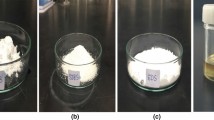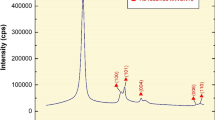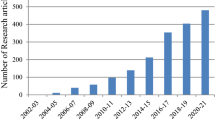Abstract
The nanofluids characterization is of fundamental importance to predict their applicability in a real heat transfer situation. In addition to the transport properties, the nanofluid stability is an important factor to be studied, due to the long pum**, heating, cooling and resting cycles the fluids are usually subjected to. Carbon nanotubes have great potential to be used in nanofluids, due to their high thermal conductivity and low density. However, for aqueous medium, stability requires the use of stabilization methods. This work carried out the study of the transport properties and stability of nanofluids with multiwalled carbon nanotubes (MWCNT), using three stabilization methods: Triton X-100 (TrX–MWCNT) and Arabic gum (AG–MWCNT) as surfactants and functionalized carbon nanotubes with COOH group (COOH–MWCNT). These three nanofluids were compared to investigate the best configuration for heat transfer processes. The thermal conductivity was studied using the hot wire method; rheology was studied through three curves in rotational rheometer of concentric cylinders; specific heat was studied by the differential scanning calorimetry method; density was measured by the Coriolis Effect method; nanoparticles size and zeta potential were measured by the dynamic light scattering method. The COOH–MWCNT nanofluids present the highest thermal conductivity increase reaching 15% at 60 °C and 12% at 30 °C with 1wt% while the A.G–MWCNT and TrX–MWCNT reach 11% and 7.5%, respectively, at 30 °C. A.G–MWCNT nanofluids showed greater stability after long sonication times, while COOH–MWCNT presents best dispersion at 0.125 and 0.25 wt%, from 40 to 160 min of sonication. The specific heat increases with temperature and decreases with MWCNT concentration; however, it presents a peculiar increase in the concentration of 0.25 wt%, increasing about 0.5% and 4.5% for A.G–MWCNT and COOH–MWCNT, respectively at 60 °C. COOH–MWCNT nanofluids showed a thixotropic behavior for 0.5 and 1.0 wt% and large viscosity increase reaching 3.75 and 5.5 times the base fluid viscosity at 5 °C and 60 °C, respectively, with 1 wt%. The nanofluids A.G–MWCNT and COOH–MWCNT present good stability, as well as an increase in transport properties, optimized at a concentration close to 0.25 wt% and the COOH–MWCNT nanofluids can be stabilized simply by changing the water pH.
Graphic abstract






















Similar content being viewed by others
Abbreviations
- MWCNT:
-
Multi-walled carbon nanotubes
- –COOH:
-
Carboxilic acid group
- MWCNT–COOH:
-
Functionalized multi-walled carbon nanotubes
- A.G–MWCNT:
-
Multi-walled carbon nanotubes nanofluid with Arabic gum
- TrX–MWCNT:
-
Multi-walled carbon nanotubes nanofluid with Triton X-100
- COOH–MWCNT:
-
Functionalized multi-walled carbon nanotubes nanofluid
- µ:
-
Apparent dynamic viscosity (Pa.s)
- E0 :
-
Activation energy (kJ/mol)
- T:
-
Temperature (°C)
- R:
-
Universal gas constant (8.3144598(48) J⋅mol−1⋅K−1)
- K:
-
Thermal conductivity (W/m K)
- Ρ:
-
Density (kg/m3)
- C:
-
Specific heat (J/(kg.K)
- Nf:
-
Nanofluid
- Bf:
-
Base fluid
- Wt:
-
Water
References
Vajjha RS, Das DK (2012) A review and analysis on influence of temperature and concentration of nanofluids on thermophysical properties, heat transfer and pum** power. Int J Heat Mass Transf 55(15–16):4063–4078. https://doi.org/10.1016/j.ijheatmasstransfer.2012.03.048
Saidur R, Leong KY, Mohammad HA (2011) A review on applications and challenges of nanofluids. Renew Sustain Energy Rev. https://doi.org/10.1016/j.rser.2010.11.035
Das SK, Choi SUS, Patel HE (2006) Heat transfer in nanofluids—A review. Heat Transfer Eng 27(10):3–19. https://doi.org/10.1080/01457630600904593
Wang XQ, Mujumdar AS (2008) A review on nanofluids—part II: experiments and applications. Braz J Chem Eng 25(4):631–648
Yu W, France DM, Timofeeva EV, Singh D, Routbort JL (2012) Comparative review of turbulent heat transfer of nanofluids. Int J Heat Mass Transf 55(21–22):5380–5396. https://doi.org/10.1016/j.ijheatmasstransfer.2012.06.034
Ghalandari M, Maleki A, Haghighi A, Shadloo MS, Nazari MA, Tlili I (2020) Applications of nanofluids containing carbon nanotubes in solar energy systems: a review. J Mol Liq. https://doi.org/10.1016/j.molliq.2020.113476
Han Z, Fina A (2011) Thermal conductivity of carbon nanotubes and their polymer nanocomposites: a review. Prog Polym Sci 36(7):914–944. https://doi.org/10.1016/j.progpolymsci.2010.11.004
Walvekar R, Faris IA, Khalid M (2012) Thermal conductivity of carbon nanotube nanofluid-Experimental and theoretical study. Heat Transfer-Asian Res 41(2):145–163
Alous S, Kayfeci M, Uysal A (2019) Experimental investigations of using MWCNTs and graphene nanoplatelets water-based nanofluids as coolants in PVT systems. Appl Therm Eng 162:114265. https://doi.org/10.1016/j.applthermaleng.2019.114265
Sadri R et al (2014) An experimental study on thermal conductivity and viscosity of nanofluids containing carbon nanotubes. Nanoscale Res Lett 9(1):151. https://doi.org/10.1186/1556-276X-9-151
Rashmi W, Khalid M, Ismail AF, Saidur R, Rashid AK (2015) Experimental and numerical investigation of heat transfer in CNT nanofluids. J Exper Nanosci 10(7):545–563. https://doi.org/10.1080/17458080.2013.848296
Fadhillahanafi NM, Leong KY, Risby MS (2013) Stability and thermal conductivity characteristics of carbon nanotube based nanofluids. Int J Autom Mech Eng 8(1):1376–1384
Garg A, Sinnott SB (1998) Effect of chemical functionalization on the mechanical properties of carbon nanotubes. Chem Phys Lett 295(4):273–278. https://doi.org/10.1016/S0009-2614(98)00969-5
Kuzmany H, Kukovecz A, Simon F, Holzweber M, Kramberger C, Pichler T (2004) Functionalization of carbon nanotubes. Synth Met 141(1–2):113–122. https://doi.org/10.1016/j.synthmet.2003.08.018
Geng Y, Liu MY, Li J, Shi XM, Kim JK (2008) Effects of surfactant treatment on mechanical and electrical properties of CNT/epoxy nanocomposites. Compos A Appl Sci Manuf 39(12):1876–1883
Rastogi R, Kaushal R, Tripathi SK, Sharma AL, Kaur I, Bharadwaj LM (2008) Comparative study of carbon nanotube dispersion using surfactants. J Colloid Interface Sci 328(2):421–428. https://doi.org/10.1016/j.jcis.2008.09.015
**ao Q, Wang PH, Ji LL, Tan XK, Ouyang LL (2007) Dispersion of carbon nanotubes in aqueous solution with cationic surfactant CTAB. Wuji Cailiao Xuebao/J Inorg Mater 22(6):1122–1126
Sun Z, Nicolosi V, Rickard D, Bergin SD, Aherne D, Coleman JN (2008) Quantitative evaluation of surfactant-stabilized single-walled carbon nanotubes: dispersion quality and its correlation with zeta potential. J Phys Chem C 112(29):10692–10699
Wang H (2009) Dispersing carbon nanotubes using surfactants. Curr Opin Colloid Interface Sci 14(5):364–371
Ruan B, Jacobi AM (2012) Ultrasonication effects on thermal and rheological properties of carbon nanotube suspensions. Nanoscale Res Lett 7:1–14. https://doi.org/10.1186/1556-276X-7-1
Garg P, Alvarado JL, Marsh C, Carlson TA, Kessler DA, Annamalai K (2009) An experimental study on the effect of ultrasonication on viscosity and heat transfer performance of multi-wall carbon nanotube-based aqueous nanofluids. Int J Heat Mass Transf 52(21–22):5090–5101
Gupta N, Gupta SM, Sharma SK (2020) Preparation of stable metal/COOH-MWCNT hybrid nanofluid. Mater Today: Proc. https://doi.org/10.1016/j.matpr.2020.04.492
Mananghaya M, Promentilla MA, Aviso K, Tan R (2016) Theoretical investigation of the solubilization of COOH-functionalized single wall carbon nanotubes in water. J Mol Liq 215:780–786. https://doi.org/10.1016/j.molliq.2016.01.041
Sharaf OZ, Taylor RA, Abu-Nada E (2020) On the colloidal and chemical stability of solar nanofluids: from nanoscale interactions to recent advances. Phys Rep 867:1–84. https://doi.org/10.1016/j.physrep.2020.04.005
Hemmat Esfe M, Saedodin S, Mahian O, Wongwises S (2014) Thermophysical properties, heat transfer and pressure drop of COOH-functionalized multi walled carbon nanotubes/water nanofluids. Int Commun Heat Mass Transf. https://doi.org/10.1016/j.icheatmasstransfer.2014.08.037
Glory J, Bonetti M, Helezen M, Mayne-L'Hermite M, Reynaud C (2008) Thermal and electrical conductivities of water-based nanofluids prepared with long multiwalled carbon nanotubes. J Appl Phys 103(9):094309
Ding Y, Alias H, Wen D, Williams RA (2006) Heat transfer of aqueous suspensions of carbon nanotubes (CNT nanofluids). Int J Heat Mass Transf 49(1–2):240–250. https://doi.org/10.1016/j.ijheatmasstransfer.2005.07.009
Akhavan-Behabadi MA, Shahidi M, Aligoodarz MR, Fakoor-Pakdaman M (2016) An experimental investigation on rheological properties and heat transfer performance of MWCNT-water nanofluid flow inside vertical tubes. Appl Therm Eng 106:916–924. https://doi.org/10.1016/j.applthermaleng.2016.06.076
**ng M, Yu J, Wang R (2015) Thermo-physical properties of water-based single-walled carbon nanotube nanofluid as advanced coolant. Appl Thermal Eng 87:344–351. https://doi.org/10.1016/j.applthermaleng.2015.05.033
Yu L, Bian Y, Liu Y, Xu X (2019) Experimental investigation on rheological properties of water based nanofluids with low MWCNT concentrations. Int J Heat Mass Transf 135:175–185. https://doi.org/10.1016/j.ijheatmasstransfer.2019.01.120
Wusiman K, Jeong H, Tulugan K, Afrianto H, Chung H (2013) Thermal performance of multi-walled carbon nanotubes (MWCNTs) in aqueous suspensions with surfactants SDBS and SDS. Int Commun Heat Mass Transfer 41:28–33
Phuoc TX, Massoudi M, Chen RH (2011) Viscosity and thermal conductivity of nanofluids containing multi-walled carbon nanotubes stabilized by chitosan. Int J Therm Sci 50:12–18. https://doi.org/10.1016/j.ijthermalsci.2010.09.008
Indhuja A, Suganthi KS, Manikandan S, Rajan KS (2013) Viscosity and thermal conductivity of dispersions of gum arabic capped MWCNT in water: influence of MWCNT concentration and temperature. J Taiwan Inst Chem Eng 44(3):474–479
Hemmat Esfe M, Saedodin S, Mahian O, Wongwises S (2014) Heat transfer characteristics and pressure drop of of COOH-functionalized DWCNTs/water nanofluid in turbulent flow at low concentrations. Int J Heat Mass Transf 73:186–194
Shen VK, Siderius DW, Krekelberg WP, Hatch HW (eds) NIST standard reference simulation website, NIST Standard Reference Database Number 173, National Institute of Standards and Technology, Gaithersburg MD, 20899. https://doi.org/10.18434/T4M88Q (retrieved)
Müller RH (1996) Zetapotential und partikelladung in der laborpraxis. Wissenschaftliche Verlagsgesellschaft, Stuttgard, p 254
White B, Banerjee S, O'Brien S, Turro NJ, Herman IP (2007) Zeta-potential measurements of surfactant-wrapped individual single-walled carbon nanotubes. J Phys Chem C 111(37):13684–13690
Hallett J (1963) The temperature dependence of the viscosity of supercooled water. Proc Phys Soc 82(6):1046
BN Taylor (1994) Guidelines for evaluating and expressing the uncertainty of NIST measurement results [microform]/Barry N. Taylor and Chris E. Kuyatt (NIST technical note ; 1297, no. Accessed from https://nla.gov.au/nla.cat-vn4078601). Gaithersburg, MD: U.S. Dept. of Commerce, Technology Administration, National Institute of Standards and Technology
Qu J, Tian M, Han X, Zhang R, Wang Q (2017) Photo-thermal conversion characteristics of MWCNT–H2O nanofluids for direct solar thermal energy absorption applications. Appl Thermal Eng 124:486–493. https://doi.org/10.1016/j.applthermaleng.2017.06.063
Moore VC et al (2003) Individually suspended single-walled carbon nanotubes in various surfactants. Nano Lett 3(10):1379–1382. https://doi.org/10.1021/nl034524j
Islam MF, Rojas E, Bergey DM, Johnson AT, Yodh AG (2003) High Weight Fraction Surfactant Solubilization of Single-Wall Carbon Nanotubes in Water. Nano Lett 3(2):269–273. https://doi.org/10.1021/nl025924u
Talaei Z, Mahjoub AR, Rashidi AM, Amrollahi A, Emami Meibodi M (2011) The effect of functionalized group concentration on the stability and thermal conductivity of carbon nanotube fluid as heat transfer media. Int Commun Heat Mass Transf 38(4):513–517
Namilae S, Chandra N, Shet C (2004) Mechanical behavior of functionalized nanotubes. Chem Phys Lett 387(4–6):247–252. https://doi.org/10.1016/j.cplett.2004.01.104
Chen J et al (2001) Dissolution of full-length single-walled carbon nanotubes. J Phys Chem B 105(13):2525–2528. https://doi.org/10.1021/jp002596i
Gulotty R, Castellino M, Jagdale P, Tagliaferro A, Balandin AA (2013) Effects of functionalization on thermal properties of single-wall and multi-wall carbon nanotube-polymer nanocomposites. ACS Nano 7(6):5114–5121. https://doi.org/10.1021/nn400726g
Yu J, Grossiord N, Koning CE, Loos J (2007) Controlling the dispersion of multi-wall carbon nanotubes in aqueous surfactant solution. Carbon 45(3):618–623. https://doi.org/10.1016/j.carbon.2006.10.010
Koshio A, Yudasaka M, Iijima S (2001) Thermal degradation of ragged single-wall carbon nanotubes produced by polymer-assisted ultrasonication. Chem Phys Lett 341(5–6):461–466. https://doi.org/10.1016/S0009-2614(01)00507-3
Wen D, Ding Y (2004) Effective thermal conductivity of aqueous suspensions of carbon nanotubes (carbon nanotube nanofluids). J Thermophys Heat Transf 18:481–485. https://doi.org/10.2514/1.9934
**e H, Lee H, Youn W, Choi M (2003) Nanofluids containing multiwalled carbon nanotubes and their enhanced thermal conductivities. J Appl Phys 94:4967–4971. https://doi.org/10.1063/1.1613374
Sabiha MA, Mostafizur RM, Saidur R, Mekhilef S (2016) Experimental investigation on thermo physical properties of single walled carbon nanotube nanofluids. Int J Heat Mass Transf 93:862–871. https://doi.org/10.1016/j.ijheatmasstransfer.2015.10.071
Lijesh P, Muzakkir SM, Hirani H (2015) Experimental tribological performance evaluation of nano lubricant using multi-walled carbon nano-tubes (MWCNT). Int J Appl Eng Res 10:14543–14550
Ge X, **a Y, Feng X (2016) Influence of carbon nanotubes on conductive capacity and tribological characteristics of poly(ethylene glycol-ran-propylene glycol) monobutyl ether as base oil of grease. J Tribol-Trans Asme. https://doi.org/10.1115/1.4031232
Nanda J et al (2008) Thermal conductivity of single-wall carbon nanotube dispersions: role of interfacial effects. J Phys Chem C 112(3):654–658. https://doi.org/10.1021/jp711164h
Fakoor Pakdaman M, Akhavan-Behabadi MA, Razi P (2012) An experimental investigation on thermo-physical properties and overall performance of MWCNT/heat transfer oil nanofluid flow inside vertical helically coiled tubes. Exp Thermal Fluid Sci 40:103–111. https://doi.org/10.1016/j.expthermflusci.2012.02.005
Kumaresan V, Velraj R (2012) Experimental investigation of the thermo-physical properties of water–ethylene glycol mixture based CNT nanofluids. Thermochim Acta 545:180–186. https://doi.org/10.1016/j.tca.2012.07.017
Laurent C, Flahaut E, Peigney A (2010) The weight and density of carbon nanotubes versus the number of walls and diameter. Carbon 48(10):2994–2996. https://doi.org/10.1016/j.carbon.2010.04.010
Amiri A, Shanbedi M, AliAkbarzade MJ (2016) The specific heat capacity, effective thermal conductivity, density, and viscosity of coolants containing carboxylic acid functionalized multi-walled carbon nanotubes. J Dispers Sci Technol 37(7):949–955. https://doi.org/10.1080/01932691.2015.1074588
Srinivas V, Moorthy CVKNSN, Dedeepya V, Manikanta PV, Satish V (2016) Nanofluids with CNTs for automotive applications. Heat Mass Transfer/Waerme-und Stoffuebertrag 52(4):701–712. https://doi.org/10.1007/s00231-015-1588-1
Acknowledgements
“The authors gratefully acknowledge the support given to the reported investigation by CAPES (Coordenação de Aperfeiçoamento de Pessoal de Nível Superior) Foundation. The recognition is extended to the University of Campinas (UNICAMP, Brazil) and to the University of Coruña (Spain) for their active support to the investigation.”
Author information
Authors and Affiliations
Corresponding author
Additional information
Technical Editor: Ahmad Arabkoohsar.
Publisher's Note
Springer Nature remains neutral with regard to jurisdictional claims in published maps and institutional affiliations.
This article has been selected for a Topical Issue of this journal on Nanoparticles and Passive-Enhancement Methods in Energy.
Rights and permissions
About this article
Cite this article
Freitas, S.S., Silveira, V., Jabardo, J.M.S. et al. MWCNT and COOH–MWCNT aqueous nanofluids: thermophysical and rheological characterization. J Braz. Soc. Mech. Sci. Eng. 42, 439 (2020). https://doi.org/10.1007/s40430-020-02507-y
Received:
Accepted:
Published:
DOI: https://doi.org/10.1007/s40430-020-02507-y




